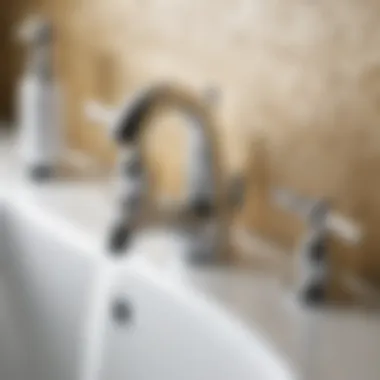Expert Guide: Mastering Bathroom Faucet Repair Techniques


Materials:
- Wrench
- Screwdriver
- Replacement washers
- Sealant tape
- Cleaning brush
- Bucket for water collection
DIY Steps:
- Start by turning off water supply to the faucet.
- Use the wrench to loosen and remove the faucet handle.
- Inspect the washers for damage and replace if necessary.
- Apply sealant tape to ensure secure connections.
- Clean any debris or sediment from the faucet with a brush and collected in a bucket.
Technical Aspects:
- Timing: Allocate 1-2 hours for this project.
- Tools: Adjustable wrench, Phillips screwdriver.
- Critical techniques: Proper handling of fragile parts, precise tightening of connections.
DIY Project Process:
- Carefully reinstall the faucet handle and tighten with the wrench.
- Turn on the water supply and test for leaks.
- Troubleshooting Tips: If leaks persist, check the seals and washers for proper installation.
Introduction
In this in-depth guide on repairing a bathroom faucet, we delve into the essential steps required to restore functionality to this crucial fixture in your home. Ensuring a properly functioning bathroom faucet is not just about convenience but also about maintaining a hygienic and efficient space within your household. When a faucet malfunctions, it can disrupt your daily routine and even lead to potential water wastage and increased utility bills. By understanding how to repair a bathroom faucet, you can save time and money by addressing issues promptly and effectively.
Understanding the Importance of a Functional Bathroom Faucet
A functional bathroom faucet is a fundamental component of any modern household, facilitating hygiene practices and offering convenience in accessing water for various purposes. Whether it's washing your hands, brushing your teeth, or cleaning the sink, a reliable faucet ensures a smooth flow of water when needed. A malfunctioning faucet can not only be frustrating but also lead to water leaks, reduced water pressure, or even complete blockages. By addressing faucet issues promptly, you can prevent potential water damage, mold growth, and wastage, contributing to a sustainable and efficient living environment.
Common Signs of a Faulty Bathroom Faucet
Identifying the signs of a faulty bathroom faucet is crucial in determining when repairs are needed. Common indicators include persistent dripping or leaking, reduced water pressure, irregular water flow, or unusual noises when the faucet is in use. These issues can stem from various causes such as worn-out components, mineral build-up, or loose fittings. By recognizing these signs early on, you can take proactive steps to investigate and resolve the underlying problems, ensuring that your faucet operates smoothly and efficiently.
Overview of the Repair Process
The repair process for a bathroom faucet typically involves a systematic approach to disassembling, identifying issues, and reassembling the components. Before starting any repair work, it's essential to gather the necessary tools and materials, such as an adjustable wrench, screwdriver set, plumber's tape, and any replacement parts that may be required. Once you have prepared the work area and turned off the water supply, you can begin disassembling the faucet to access and assess the internal components. By following a methodical step-by-step process, you can effectively troubleshoot and fix common issues such as leaks, low water pressure, or strange noises in your bathroom faucet, restoring it to optimal working condition.
Preparation
In the realm of repairing a bathroom faucet, the pivotal stage of preparation holds utmost importance. As the foundation upon which the entire repair process is built, thorough preparation significantly influences the outcome of the task at hand. By meticulously following the preparation guidelines outlined in this article, individuals can streamline the repair process, ensure efficiency, and minimize the likelihood of errors or complications. Not only does adequate preparation save time in the long run, but it also contributes to a successful and satisfactory repair outcome.


Gathering Necessary Tools and Materials
Adjustable Wrench
An indispensable tool in any plumbing repair toolkit, the adjustable wrench offers unparalleled versatility and functionality when working with varying sizes of nuts and bolts. The key characteristic of an adjustable wrench lies in its ability to adapt to different sizes of fasteners, making it an essential asset in tackling faucet-related repairs. Its ergonomic design and ease of use make it a popular choice for both amateurs and professionals alike. However, one potential drawback of an adjustable wrench is the possibility of slipping on round or damaged fasteners, necessitating a secure grip for optimal performance.
Screwdriver Set
A comprehensive screwdriver set is crucial for disassembling and reassembling various components of a bathroom faucet. With a range of Phillips and flat-head screwdrivers, this set ensures that individuals have the right tool for any screw type encountered during the repair process. The key characteristic of a screwdriver set lies in its versatility and precision, allowing for efficient handling of screws in tight or hard-to-reach spaces. While the set's diverse range of heads provides adaptability, users must exercise caution to avoid stripping screw heads or causing damage during use.
Plumber's Tape
Essential for creating watertight seals in plumbing connections, plumber's tape plays a vital role in preventing leaks and ensuring the longevity of faucet repairs. The key characteristic of plumber's tape is its ability to form a tight seal when wrapped around pipe threads, effectively preventing water leakage. Its ease of application and affordability make it a popular choice for sealing pipe fittings and preventing corrosion in plumbing systems. However, users should take care not to over-tighten connections when using plumber's tape to avoid damage to pipes or fittings.
Replacement Parts (if needed)
When confronted with a faulty faucet component beyond repair, having replacement parts on hand is imperative for a seamless repair process. Whether it's a worn-out washer, a damaged O-ring, or a malfunctioning valve, stocking up on essential replacement parts ensures that repairs can be completed promptly and effectively. The key characteristic of having replacement parts readily available is the ability to minimize downtime and swiftly address issues as they arise. While the convenience of having replacement parts on hand accelerates the repair process, it is essential to choose high-quality, compatible parts to maintain the faucet's optimal functionality without compromising performance.
Turning Off the Water Supply
In any plumbing repair endeavor, including the repair of a bathroom faucet, shutting off the water supply is a critical step to prevent water damage and ensure a safe working environment. Whether repairing a leaky faucet or replacing components, turning off the water supply is essential to avoid inadvertent flooding or water wastage. By taking the precaution of turning off the water supply before commencing any repair work, individuals safeguard their property and mitigate the risk of potential water-related mishaps.
Disassembly
Disassembly is a crucial aspect of the bathroom faucet repair process. By understanding how to properly disassemble the faucet, you gain access to the inner components that may be causing issues. This step allows you to visually inspect, clean, and replace any worn-out parts, ensuring optimal functionality of your faucet. Proper disassembly also prevents accidental damage to the faucet during repair.
Removing the Faucet Handle
Removing the faucet handle is one of the initial steps in the disassembly process. Begin by locating the set screw or cover cap on the handle. Use an appropriate tool such as a screwdriver or hex key to unscrew or pry off the handle cover. Once the cover is removed, you can access the handle screw. Loosen and remove the screw carefully, ensuring not to strip or damage it. With the screw out, gently pull the handle upwards to detach it from the faucet body. Inspect the handle for any damage or buildup that may be contributing to the faucet issue.
Taking Apart the Faucet Components
After removing the handle, proceed to disassemble the faucet components. Depending on the faucet type, this may involve unscrewing nuts, cartridges, or retaining rings that secure the inner parts. Use the appropriate tools such as an adjustable wrench or pliers to carefully loosen and remove these components. As you disassemble, take note of the order and orientation of each part to facilitate reassembly later. Inspect the components for any signs of wear, buildup, or damage. Cleaning these parts thoroughly can help improve faucet performance and longevity.
Identifying and Fixing Issues


Leaks and Drips
Replacing O-Rings
When it comes to addressing leaks and drips in your bathroom faucet, replacing O-rings emerges as a key solution. O-rings serve as seals in the faucet to prevent water from leaking out. Their flexibility and resilience make them a popular choice for maintaining a watertight seal in faucets. Replacing O-rings is a beneficial step in this repair process as it helps rectify leakages efficiently. However, it is essential to note that while O-rings are durable, they may degrade over time due to constant usage, leading to leaks. Thus, understanding how to replace O-rings is crucial in maintaining a functional faucet.
Tightening Loose Parts
Another common issue contributing to leaks and drips in bathroom faucets is loose parts. Tightening these components is a fundamental step in addressing such problems. Loose parts can disrupt the smooth flow of water, causing leaks and discomfort. By tightening these parts appropriately, you restore the stability of the faucet and prevent water wastage. A key advantage of tightening loose parts is that it is a simple yet effective solution that can be done with basic tools, saving you time and hassle. However, excessively tightening parts can lead to damage, emphasizing the importance of precision in this task.
Low Water Pressure
When encountering low water pressure in your bathroom faucet, understanding the root causes and potential solutions is paramount for a successful repair process. Let's explore two critical aspects related to low water pressure and how they contribute to maintaining a fully functional faucet.
Cleaning Aerator
The aerator in a faucet is responsible for mixing air with the water flow, ensuring a steady stream while reducing splashing. Cleaning the aerator is a vital step in resolving low water pressure issues, as mineral deposits or debris may accumulate over time, impeding water flow. The key characteristic of cleaning the aerator lies in its ability to enhance water pressure and streamline the flow. This simple maintenance task can significantly improve the performance of your faucet, providing a more comfortable user experience.
Checking for Debris in Pipes
Another factor that can result in low water pressure is the presence of debris in the plumbing pipes. Checking for debris and removing any obstructions can restore water flow to its optimal level. By addressing this issue, you prevent potential blockages that may hinder the efficient operation of your faucet. The unique feature of this step is its direct impact on water pressure, ensuring that your faucet functions flawlessly. However, it is essential to exercise caution while removing debris to prevent damage to the pipes.
Strange Noises
Unusual noises emanating from your faucet can be a cause for concern and may indicate underlying issues that require attention. Let's examine a specific aspect related to addressing strange noises and how it contributes to maintaining a quiet and smoothly functioning faucet.
Securing Loose Components
Securing loose components within the faucet is pivotal in eliminating strange noises that may occur during operation. Loose components can rattle or vibrate, resulting in disruptive sounds that affect the overall user experience. By fastening these components securely, you eliminate the source of the noise, promoting a tranquil environment in your bathroom. The key characteristic of securing loose components lies in its ability to enhance the performance of the faucet by minimizing disturbances. While this task may appear simple, its impact on noise reduction is significant, providing a more pleasant experience for users.
Reassembly
Putting Back Faucet Components
When putting back faucet components during the reassembly process, it is crucial to refer back to any notes or photographs taken during disassembly. This step helps to ensure that each part is positioned correctly and securely reattached. Careful attention should be given to aligning each component in the right order, as even a minor mistake can lead to malfunctions or leaks in the future. Tightening all connections firmly but not excessively is essential to prevent water leakage and maintain the faucet's longevity.


Reattaching the Faucet Handle
Reattaching the faucet handle is a specific aspect of reassembly that requires precision to ensure the smooth operation of the faucet. Firstly, it's essential to confirm that the handle is aligned correctly with the valve stem before securing it in place. Proper alignment prevents any issues with turning the handle and helps maintain the ergonomic function of the faucet. Securing the handle with the appropriate screws or fasteners, according to the faucet model, is key to providing stability and ease of use in daily activities within the bathroom.
Testing and Final Steps
In the intricate process of repairing a malfunctioning bathroom faucet, the testing and final steps hold paramount importance. Once all the necessary repairs have been conducted, this stage serves as the ultimate litmus test to ensure that the faucet functions seamlessly. Turning on the water supply and testing the faucet not only validates the effectiveness of the repair work but also guarantees the restoration of full functionality to your bathroom fixture. It is the conclusive phase that transitions your faucet from a flawed state to one of optimal performance.
Turning On Water Supply and Testing Faucet
Turning on the water supply and testing the faucet following repairs is a critical step to ascertain that the implemented fixes have been successful. This process involves gradually reopening the water valves and observing the flow and behavior of water from the faucet. By doing so, you can confirm that the issues causing the initial malfunction have been resolved and that the faucet now operates as intended. It is prudent to monitor the flow carefully to detect any irregularities that may require further adjustment.
Checking for Leaks
Upon testing the faucet, checking for leaks is imperative to ensure that the repair has been thorough. Inspect the area around the faucet for any signs of water leakage, including drips or moisture accumulation. Addressing leaks promptly can prevent water wastage and safeguard your surroundings from potential water damage. This step not only confirms the success of the repair but also reinforces the longevity and effectiveness of your faucet.
Cleaning Up the Work Area
As the final touch to your repair endeavor, cleaning up the work area is essential for maintaining a tidy and organized space. Dispose of any debris, unused materials, and tools that may clutter the area. Wipe down the surrounding surfaces to remove any residues or stains accumulated during the repair process. By restoring order to the work environment, you not only enhance safety but also cultivate a sense of accomplishment after successfully repairing your bathroom faucet.
Maintenance Tips
Maintenance is key to ensuring your bathroom faucet remains in optimal condition for years to come. By incorporating regular maintenance practices into your routine, you can prevent potential issues and extend the lifespan of your faucet. This section will delve into essential maintenance tips that will help you keep your bathroom faucet functioning smoothly.
Regularly Cleaning Faucet Components
Properly maintaining your faucet components is crucial in preventing build-up, corrosion, and other potential problems. Regularly cleaning the aerator, spout, handles, and other faucet parts will not only keep your faucet looking pristine but also ensure it functions efficiently. Over time, minerals and debris can accumulate in these components, leading to reduced water flow and potential leaks. By incorporating a simple cleaning routine using mild soap, a soft-bristled brush, and vinegar for hard water stains, you can effectively extend the lifespan of your faucet.
Promptly Addressing Any Issues
Timely intervention is essential when it comes to addressing any issues with your bathroom faucet. Ignoring minor leaks, drips, or low water pressure can escalate into major problems that may require costly repairs or replacements. By promptly addressing any issues that arise, you can prevent further damage and ensure the longevity of your faucet. Whether it's tightening a loose part, replacing a worn-out washer, or seeking professional assistance for complex issues, taking swift action can save you time, money, and hassle in the long run. Remember, proactive maintenance is the key to a smoothly functioning bathroom faucet.
Conclusion
As we draw the curtains on this comprehensive guide to repairing a bathroom faucet, it's essential to reflect on the crucial information and insights shared throughout the various sections. The conclusion of this article encapsulates the significance of following a systematic approach when dealing with a malfunctioning bathroom faucet.
One of the key takeaways from this guide is the emphasis on proactive maintenance to prevent costly repairs down the line. By regularly cleaning faucet components and promptly addressing any issues that arise, homeowners can ensure the long-term functionality of their bathroom fixtures.
Furthermore, the guide underscores the importance of thorough preparation before initiating any repair work. Gathering the necessary tools and materials, as outlined in the preparation section, sets the stage for a smooth repair process free of unnecessary delays or complications.
Additionally, the testing and final steps highlighted in the guide serve as a crucial phase to ensure that the repaired faucet operates optimally. By rigorously testing the faucet, checking for leaks, and cleaning up the work area, DIY enthusiasts can rest assured that their efforts have been successful.







